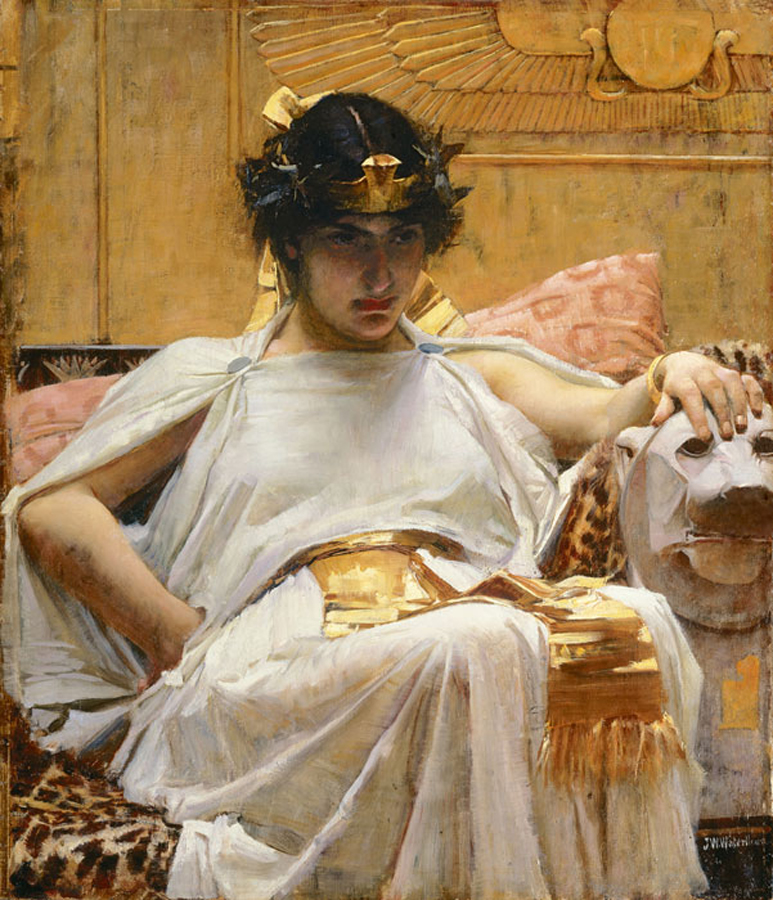
Cleopatra VII Philopator was the last active ruler of the Ptolemaic Kingdom of Egypt, nominally survived as pharaoh by her son Caesarion. As a member of the Ptolemaic dynasty, she was a descendant of its founder Ptolemy I Soter, a Macedonian Greek general and companion of Alexander the Great.
After the death of Cleopatra, Egypt became a province of the Roman Empire, marking the end of the Hellenistic period that had lasted since the reign of Alexander (336–323 BC). Her native language was Koine Greek, and she was the first Ptolemaic ruler to learn the Egyptian language.
In 58 BC, Cleopatra presumably accompanied her father Ptolemy XII during his exile to Rome after a revolt in Egypt, a Roman client state, allowed his daughter Berenice IV to claim the throne. Berenice was killed in 55 BC when the king returned to Egypt with Roman military assistance.
When he died in 51 BC, the joint reign of Cleopatra and her brother Ptolemy XIII began. A falling-out between them led to open civil war. After losing the 48 BC Battle of Pharsalus in Greece against his rival Julius Caesar (a Roman dictator and consul) in Caesar’s Civil War, the Roman statesman Pompey fled to Egypt, where Ptolemy had him killed while Caesar occupied Alexandria. Caesar had attempted to reconcile the siblings, but Ptolemy’s chief adviser Potheinos viewed Caesar’s terms as favoring Cleopatra, so his forces besieged her and Caesar at the palace.
Shortly after the siege was lifted by reinforcements, Ptolemy died in the 47 BC Battle of the Nile. His sister Arsinoe IV was eventually exiled to Ephesus for her role in carrying out the siege. Caesar declared Cleopatra and her brother Ptolemy XIV joint rulers, but maintained a private affair with Cleopatra that produced Caesarion.
Cleopatra traveled to Rome as a client queen in 46 and 44 BC, where she stayed at Caesar’s villa. After the assassinations of Caesar and (on her orders) Ptolemy XIV in 44 BC, she named Caesarion co-ruler.
In the Liberators’ civil war of 43–42 BC, Cleopatra sided with the Roman Second Triumvirate formed by Caesar’s grandnephew and heir Octavian, Mark Antony, and Marcus Aemilius Lepidus. After their meeting at Tarsos in 41 BC, the queen had an affair with Antony. He carried out the execution of Arsinoe at her request, and became increasingly reliant on Cleopatra for both funding and military aid during his invasions of the Parthian Empire and Kingdom of Armenia. The Donations of Alexandria declared their children Alexander Helios, Cleopatra Selene II, and Ptolemy Philadelphus rulers over various erstwhile territories under Antony’s triumviral authority.
The Battle of Actium
This event, their marriage, and Antony’s divorce of Octavian’s sister Octavia Minor led to the Final War of the Roman Republic. Octavian engaged in a war of propaganda, forced Antony’s allies in the Roman Senate to flee Rome in 32 BC, and declared war on Cleopatra. After defeating Antony and Cleopatra’s naval fleet at the 31 BC Battle of Actium, Octavian’s forces invaded Egypt in 30 BC and defeated Antony, leading to Antony’s suicide.
When Cleopatra learned that Octavian planned to bring her to his Roman triumphal procession, she committed suicide by poisoning (contrary to the popular belief that she was bitten by an asp).
Cleopatra’s legacy survives in ancient and modern works of art. Roman historiography and Latin poetry produced a generally critical view of the queen that pervaded later Medieval and Renaissance literature. In the visual arts, her ancient depictions include Roman busts, paintings, and sculptures, cameo carvings and glass, Ptolemaic and Roman coinage, and reliefs.
In Renaissance and Baroque art she was the subject of many works including operas, paintings, poetry, sculptures, and theatrical dramas. She has become a pop culture icon of Egyptomania since the Victorian era, and in modern times Cleopatra has appeared in the applied and fine arts, burlesque satire, Hollywood films, and brand images for commercial products. Source: Wikipedia.




